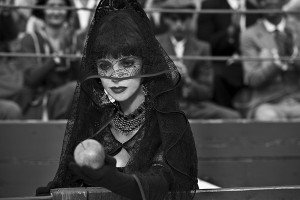film review: blancanieves
New ideas come and go in cinema, but it seems that some stories will never cease to provide inspiration. Even as technology continues to change the boundaries of filmmaking, fairy tales are not going out of fashion.
In recent years, the enduring fascination with such stories has been seen in movies like Snow White and the Huntsman, Red Riding Hood and the upcoming Cinderella. Now comes a rather unique take on Snow White (the Brothers Grimm original, rather than the Disney cartoon) in Blancanieves, a black and white silent film that infuses the fairy tale with the drama and excitement of Spanish bull-fighting.
Not only does the film have several recent fairy tale movies that it can be compared to, but its release comes not long after the Academy Award winning The Artist, another black and white silent film—it seems everything old is new again in cinema these days.
The film begins in 1920s Seville, with the dramatic scenes of famous Antonio Villalta (Daniel Gilmenez Cacho) being badly hurt. Meanwhile, his wife Carmen de Triana (Inma Cuesta) goes into labour and dies seconds after giving birth to a baby girl, Carmencita. Antonio loses the use of his arms and legs, and his cunning nurse Encarna (Maribel Verdu) takes advantage of the newly widowed and rich former bullfighter, soon becoming his second wife.
Carmencita spends her early years with her loving grandmother. When her abuela dies a sudden death, Carmencita (Sofia Oria) must live with her father and Encarna, where she is forced to live in a dirty barn and carry out many harrowing chores. The young girl grows close with her father in secret, while Encarna uses Antonio’s money to indulge in a project of her own vanity.
Carmencita learns the ways of the bullfighter from her father. When Encarna decides to get rid of Antonio once and for all, she also sends her lover to kill Carmencita (now played by Macarena Garcia). However, our heroine survives and is taken in by a group of touring bullfighting dwarfs.
When the dwarfs stage a bullfighting show and one team member is hurt, Carmencita shows her raw talent and skill. She becomes the star of the travelling show despite having no memory of her past and her father. This takes the group back to Seville, where Encarna is shocked to see that the stepdaughter she thought she had rid herself of is not only still alive, but now more famous than Encarna herself! This is where the apple comes in…
Settling into a film without dialogue is a strange experience, especially as Blancanieves opens with such drama and tragedy. For the first few scenes, it feels as though something is missing: did they leave out the scenes where the characters are introduced via expositional dialogue? Before long, though, it becomes more comfortable and the rhythm of a movie with music as its only audio is easier to follow.
It is amazing to realise that dialogue is not actually necessary in order to tell a story: powerful actors combined with the right score can tell a tale that is just as sad, just as thrilling and even just as funny as the movies we are more used to in this day and age.
Without a doubt, the most compelling character in the film is the villain—isn’t that often true of fairy tales? Despite the fact that the audience never hears her voice, Encarna is dripping with evil. Her plots to torture Carmencita are disturbing and diabolical, and the pleasure she takes in using Antonio’s money for her own amusement and indulgence is unsettlingly clear. Her relationship with her lover is another in which she exerts her power in ways that demean those around her. There is never any explanation for her evil—unlike in many other films, there is no sad background to be explained.
Fairy tales are full of archetypal characters: the sinister villain, the damsel in distress and of course, the heroic princely type to swoop in and save the day. Such tales are are often criticised for their sexism.
So is it possible to make a fairy tale give its female characters respect? Blancanieves is certainly not your typical fairy tale and Carmencita is not the typical damsel. Bullfighting is not the usual activity one would expect a fairy tale lady to be performing. As well, missing from this interpretation of Snow White is the Prince that swoops in to save the day in the final minutes, which is refreshing.
Carmencita makes a name for herself through her own talent and skill, but she is quite naive at times: this is perhaps more to do with her age and life experiences, rather than her gender. Of course, the female villain Encarna is driven largely by her vanity, which is somewhat stereotypical of “bad” female characters.
Whatever conclusions you draw about the gendered elements of this fairy tale intepretation, the film is undoubtedly captivating: its actors are skilled in bringing the story to life without colour or dialogue. It is a clever film, and has humourous moments, too. No doubt it is not the last twist on the story of Snow White we will be offered, but it is certainly one worth seeing.


